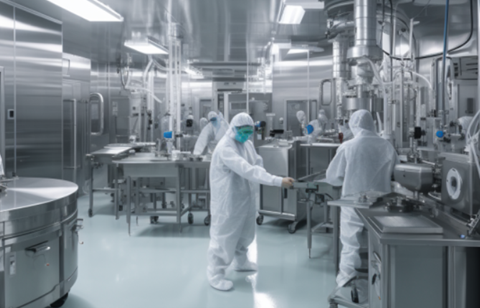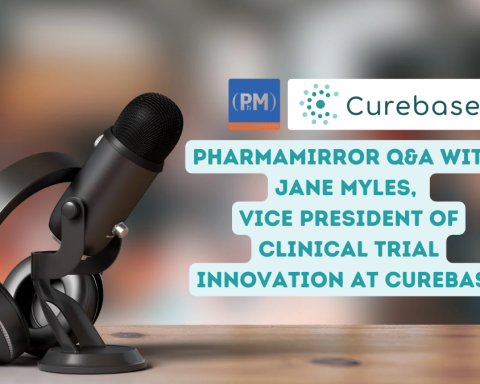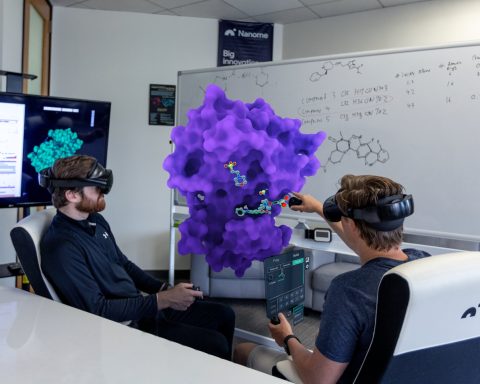Dr Marcus Hartmann is the founder and scientific head of Cilian AG, in Münster, Germany. Established in 2001, privately held Cilian develops fully recombinant vaccines, antibodies and enzymes.
Dr Hartmann is one of the leading industrial German experts, who holds few patents and has also published a number of research papers in reputed journals. One of his outstanding developments is the flu vaccine CiFlu®, that received a Scientific Advice from the Federal Institute for vaccines last year. Several German media have reported and mentioned CiFlu®, one of them is Frankfurter Rundschau – a leading daily newspaper. People like him is a blessing for the science and mankind.
Recently Fahad Hussain, Editor of Pharma Mirror Magazine has talked with Dr Hartmann, CSO of Cilian AG Germany. The excerpt of the interview is given below.
Fahad Hussain: Welcome Dr Hartmann
Dr Markus Hartmann: Thank you, it is my great pleasure to talk to you.
Fahad H: Before diving into the main topic, please tell your thoughts about the potentials of amoeba and ciliates in medical science in short.
Markus H: Ciliates are the most evolved and complex subgroup of the kingdom of protists, in which amoeba also belongs. In the world of microorganisms, ciliates are exceptional organisms with unique and fascinating features, which makes them particularly suitable for scientific investigations.
Because some ciliates can be easily grown in large quantity in the laboratory, they have been a great source for biochemical analysis for years. With the advancement of genetic techniques, ciliates have become an excellent model organism for the study the gene function in vivo. Their unique suitability for scientific investigations led to the fact that one particular ciliate species, so called Tetrahymena, which subsequently was deemed the model organism or “work horse” in bioscience, was placed by the US NIH on the list of genomes and was sequenced completely in 2006.
Tetrahymena finally reached full international recognition as model organism with the award of Nobel Prizes for researchers using this organism in their scientific work. Twice in the past, for medical science first in 1989 and then in 2009, US scientists Thomas Cech and Elizabeth Blackburn were honored along with their colleagues, for fundamental insights into certain functions of cell proliferation and protein biosynthesis, using Tetrahymena as their model organism. This model organism is predestined for biotechnology application based on its outstanding characteristics.
Fahad H: From your research and business background, it is visible that you have much fascination to these protozoans, what are the reasons behind that? If I am not wrong, you named your company ‘Cilian AG’ as by Ciliate. Isn’t it?
Markus H: Indeed our team and I are very much fascinated with ciliates. The scientific reason behind it is the combination of practical manageability of this microorganism in the lab and its enormous biotechnological power and productivity. But as you may be able to imagine, for a scientist there is always a first encounter, meaning: you see your study organism of interest the first time in culture under the microscope. Ciliates, especially Tetrahymena, are relatively large microorganism (1/20 mm) which you can easily see under the microscope. This impression is totally different from that, which you get from other microorganisms or cells. This, because Tetrahymena morphology (complex translucent cell body) is so different from bacteria, yeast and cells of higher organisms; latter usually are smaller and do not display movement or behavior. These features have impressed all of our scientists and technicians as they joined our research team and looked through the microscope, and this fascination continues to this very day.
At no point was it necessary to convince my scientists of Tetrahymena’s merits and potential as I set up our research team, because the fascination “infected” everybody almost immediately as they began to work with ciliates.
When we named the company, we wanted catchy and striking corporate name and were, not surprisingly, inspired by the class name “Ciliates”.
Fahad H: How did you get into the biopharmaceutical business? What did you influence the most?
Markus H: The most important factor was the stubborn will of our team and myself to do something for the direct benefit of people. With direct benefit I mean to do applied science. It was never satisfying for me simply to gain scientific insight or scientific knowledge. And it is the deepest motivation of our team, that the scientific results of our research and development efforts must always lead to direct application of the knowledge and, of course, in the mid-term, to a benefit to humans and/or animals. It is clear for us that benefit also means profitability for those individuals who put their trust in our team, our investors. This is the underlying spirit of our team. Personally, I got into contact with applied science as a graduate student in the central research laboratories of Sanofi (former Hoechst AG) in Frankfurt (Germany) and the experience with applied science in a lab of a pharmaceutical company was the motivation to ultimately become a life science researcher in the biopharmaceutical business.
Fahad H: We have come to know that, you developed a way to influence the DNA of amoebas to produce flu vaccine. How did you discover that possibility?
Markus H: Our team developed a new and innovative heterologous expression system (CIPEX-System) based on ciliates with the goal to utilize this unique production technology for the manufacturing of biopharmaceuticals. During a proof of principle study with surface proteins from viruses we demonstrated in vivo efficacy of a flu vaccine protein. The high expression yields shown for three different proteins from influenza viruses indicated a significant advantage over current production systems used for the manufacture of influenza vaccines. In fact, it turned out, that due to the fast growth of ciliates, the CIPEX-System is ideally suited for the production of protein based vaccines for seasonal virus based infectious diseases. We recognized that the production of flu vaccines is still dominated by a 50-year-old production technology and involves injecting the live virus into eggs and allowing it to proliferate. Furthermore, the relatively long lead times in the production of flu vaccines have led to renewed demands for a quicker, more reliable method of producing vaccines than the chicken-egg method. All these facts led our team to develop our recombinant flu vaccine.
Fahad H: What will be the possible mechanism of action of the flu vaccine ‘Ciflu’?
Markus H: Typically vaccination is the administration of antigenic material (a vaccine) to stimulate an individual’s immune system. Flu vaccine is the best way to protect humans against the flu and to help prevent its spread throughout the community. A flu vaccine can also reduce the severity of the flu even if a person contracts a strain of the flu that the vaccine did not contain.
In the case of ‘CiFlu’, this influenza vaccine is a subunit vaccine made from recombinant proteins. A sub unit vaccine introduces only a fragment of the typical virus, e.g. a surface protein, thereby causing an immune response. This is in contrast to introducing an inactivated or attenuated micro-organism into the body causing an immune response (therefore making it a “whole-agent” vaccine).
The subunit vaccine ‘CiFlu’ is composed of only the surface protein (called hemagglutinin) of the virus, which was previously extracted from the blood serum of chronically infected patients. The hemagglutinin is then produced by recombination of the viral genes into ciliates.
Fahad H: Are the investigated amoebas of special kind or any amoeba found in any lake?
Markus H: Cilian uses a certain ciliate species (Tetrahymena), which typically lives as a micro- organism in inland waters as its natural habitat. For the biopharmaceutical production Cilian uses specific strains of Tetrahymena that we developed in its own certified laboratories.
Fahad H: How is your vaccine superior than conventional one? Is it also cost effective comparing with that?
Markus H: As explained, ‘CiFlu” is composed of only the influenza virus surface protein called hemagglutinin, which will be produced with the CIPEX-System. The abilities of the CIPEX-System have to be considered in the context of the challenges of speed, cost effectiveness and duration of production, particularly when comparing it with the manufacturing of seasonal and pandemic flu vaccines in embryonated chicken eggs. Conventional vaccine production takes about 28 weeks. The manufacturer thus has a very short window of opportunity, which, when missed, can result in delayed supply for the population most critically susceptible to the flu. This is an unsatisfactory situation in preparing vaccines for a seasonal epidemic. In contrast to embryonated chicken egg production, Cilian anticipates to produce the recombinant subunit flu vaccine CiFlu within only 18 weeks which is about 10 weeks faster.
Due to its recombinant nature, CiFlu will not contain chicken egg protein contaminations, eliminating the risk of severe side effects of conventional influenza vaccines like the Guillain-Barré Syndrome (severe muscle weakness or “egg allergy”), a complication seen with current influenza vaccinations.
We also expect to be able to achieve significant cost effectiveness as soon as we have first results from clinical trials.
Fahad H: Why do you claim that it is more efficient and safer in production process comparing with the conventional flu vaccine production?
Markus H: The underlying advantage of our production process is partly based on the fact that CiFlu is a recombinant subunit vaccine. Recombinant subunit vaccines are created by utilizing an expression host to produce large quantities of a single viral protein. Advantages of the recombinant subunit vaccine technology are that there is virtually no chance of the host becoming ill from the agent, since it is just a single protein, not the virus itself. Conventional influenza vaccine risks come from the organism not being totally weakened (attenuated) or -in the case of killed/inactivated viruses produced in eggs or tumor cells- contaminated with host related proteins (see also under “egg allergy”), antibiotics and solvents. Another advantage of a recombinant vaccine is that it most likely does not need an adjuvant. An adjuvant is a chemical substance that stimulates (or otherwise, irritates) the immune system to find and react to the vaccine agent. Some adjuvants have been implicated in causing severe side effects over time. Last but not least conventional cumbersome large scale cultivation of living viruses in eggs or tumor cells is not only slow but also involves the risk and danger of accidental release of pathogenic agents.
Fahad H: We also know that, you are expecting human trial soon? Would you mind to share the progress?
Markus H: Cilian is planning to commence a clinical phase I study beginning in 2015 with inhibitory serum antibody determination and rates and severity of solicited and unsolicited adverse events as study endpoints. A subsequent phase IIa study is scheduled for 2016.
Fahad H: Please define the relationship among Cilian AG, Munster University and Paul-Ehrlich-Institute for this project of developing a flu vaccine.
Markus H: The University in Muenster is the place where Cilian’s particular work on ciliates once originated from. I myself am a graduate scientist from that university. The German Paul-Ehrlich-Institute (PEI) is the regulatory agency for medicines in Germany. Most of its activities relate to the various duties laid down in German and European medicinal product legislation, for example for the approval of clinical trials and the marketing authorization of medicinal products. Cilian, based on a review by the PEI, received a comprehensive scientific advice for the further investigation of the vaccine. The PEI confirmed and supported in its advice Cilian’s development plan, endorsed the proposed approach for the development of the recombinant influenza vaccine; and offered technical and regulatory advice for certain steps in the development.
Fahad H: What impact you do expect, if you could market the vaccine after successful human clinical trial?
Markus H: The biggest challenge with flu vaccines today is the timely and consistent supply of product. Conventional vaccine production has been struggling for many years to have current vaccine available in time for the flu season in sufficient quantities to at least afford adequate vaccination of the most critical population groups, such as infants and the elderly. Current production methods are also limited in their capacity which means that only a portion of the total market can be covered at any given time during the flu season.
Cilian’s flu vaccine can address all of these challenges and help everybody to afford this vital immunization. Production cycles for its vaccine are significantly shorter and capacity is not an issue since the product is recombinant. And possible improved efficacy or better cost of goods has not even taken into account yet.
Fahad H: How many innovative projects you and your company are currently handling? What is coming up next?
Markus H: Cilian is working on three other approaches involving its core technology. The most advanced after its vaccine is an fully recombinant enzyme preparation for the treatment of exocrine pancreatic insufficiency. This product is expected to represent major innovation and promises large worldwide commercial potential. We are also pursuing an approach towards significantly improving the cancer fighting abilities of existing antibodies using the ciliates’ unique glycosylation patterns. Last but not least, Cilian is also developing additional uses for its vaccine platform, for example in animals.
Fahad H: In your successful research life – how your family and friends motivate you?
Markus H: In my family there has always been a combination of fascination and curiosity for my scientific work. If you are developing new biopharmaceuticals this is of course an interesting story especially for kids and friends. I was able to combine my stories about my applied scientific work with a vivid model organism, like Tetrahymena, which I often showed my kids, my wife and my friends, under the microscope. In consequence, I was able to generate enthusiasm for my work in my family, which helped and motivated me to meet the big challenges to manage a biotech company.
Fahad H: As a biological researcher and the proud founder of Cilian AG, please tell few words to entrepreneurs and graduate students who dream like you.
Markus H: If you attempt to rise to the challenge of setting up a business like Cilian’s you need to have a group of right people on your side, colleagues as well as employees, who are prepared to go this rather unusual path. Cilian is very fortunate to have such a team of people on board. I would recommend to entrepreneurs and graduate students to give particular emphasis to the selection of their partners and their team, if and when they begin thinking about establishing a biotech company.
After all and for me personally, to be the founder of biotech company is a fantastic and exiting experience, which allowed me to get beyond ordinary scientific work and excel personally. I was able to think outside the box and learn things I would have never been able to learn as employee of a large corporation or as an academic researcher. Furthermore, I was able to move things, for which I might be proud of later on.
Fahad H: Thank you very much from Pharma Mirror Magazine.
Markus H: Thank you very much, it was a pleasure to talk with you.








